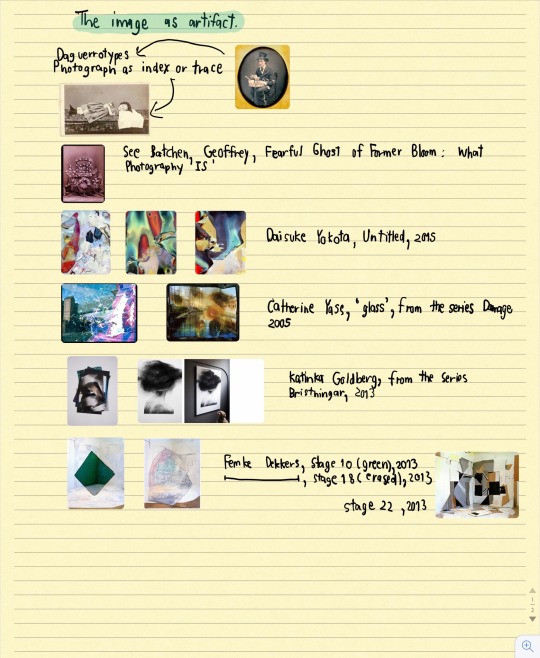#advancedmethods
Explore tagged Tumblr posts
Text
5 Best Tips for Handling APIs in React

#reactjs #apishandling #javascript #java #advancedmethod #webapp #vortexframe
1 note
·
View note
Text
Next Generation Employment Verification Facilitates Stage the Playing Field against Job-Hopping
While job-hopping portrayed as a negative term, its definition may no longer available in the current economy. Job hopping is defined as when someone who tends to move from company to company, and it was not viewed by human resource professional as a positivity since loyalty and longevity were the important values human resources looked for. At present, our economy is flexible, skilled and talented workers have many options. Employers are more open to contract work, outsourced work, part-time, and returning employees from maternity leave, which creates the traditional employee extinct.
Such workplace changes have also altered our perception of job-hopping, that resulting in more less of a stigma than within the past. On an average basis, we all spend less time in a job than we used to spend earlier, in fact, the average job duration in the United States is now lesser than 5 years. A drastic shift from the past 30 year’s attitude of the previous generation of workers. In addition to switching demographics and the rise of a casual workforce, the automation inside businesses has standardized the idea of moving from one particular job to another at a much quicker pace than in the past days. One potential outcome of job-hopping may eventually be the vogue activity, as the workforce may become more and more fluid. In the future, job-hopping may get a new name and the new term is given to those who choose to live their life experiencing and contributing to different companies instead of focusing on one or a two.
Employers View on Job-Hopping
Employees have a significantly more positive perspective on job-hopping. A recent survey conducted by New England district president of ‘Accountemps’, states that his company acknowledged 42% of workers in the United States thinks job-hopping can facilitate their career. However, human resource managers reveal that roughly five job changes in the tenure of 10 years can raise red flags.
One factor that may shape an employer’s view of job-hopping is the truth that a worker who chooses to leave speaks to lost speculation, which is the reason companies lean toward that representative’s wait. It takes a lot of time, resources and effort to find talented and skilled people to do great work, and when the employer finds them, they certainly do not want them to just pass through. Moreover, several short-term jobs for candidates may not be appealing to every employer, some companies appreciate the drive of job-hoppers to constantly grow and build their career, or the craving of past organizations to enlist them.
Benefits of Job-Hopping
According to our expert management, there are many benefits, including the opportunity to gain new skill-set and experiences, which can help advance an employee’s career. Benefits include the ability to take a new position with new responsibilities, and thus learn new skills to add weight to their resumes. This is most important because employees who remain in a single job for an extended period without gaining new skills or responsibilities can become complacent. Working for a long time is great, but not at the expense of building a more diverse skill set.
Moving quickly from job to job serves to quicken the time it takes for career enhancement. The more you increase your exposure to new opportunities, the more you can capitalize on those opportunities for skill-building, growth, and advancements. Compensation is one of the major advantages of job-hopping that this practice can increase a worker’s pay scale or provide an opportunity to gain more prominent responsibility in the workforce.
Competitive Employment Market
In recent years, the U.S. unemployment rate went from 5.3 percent to 4.9 percent, and the number of employed individuals rose by nearly 60 thousand (Bureau of Labor Statistics). Employers rejoice at the economic recovery the U.S. has made since the recession that erased nearly 9 million American jobs less than a decade ago. But as an employer’s view, we need to read between the lines of this data and understand what it means for better hiring practices.
Where many industries are facing significant talent gaps, a positive candidate experience can be between a company getting that new hire or one of their competitors getting the candidate. Candidates often express concern that screening seems like a mysterious behind-the-scene process over which they have no control.
Securecheck360 Next Generation Verification
Securecheck360 have step by step process to transform the screening experience for candidates to make screening easier, faster, and available round the clock. Our next-generation screening services are designed to provide workplace safety, and simultaneously allow you to make informed hiring decisions while minimizing legal exposure.
The next-generation of employment verification provides a transparent way for candidates to interact with Securecheck360 to speed up and simplify the screening process. It guides candidates step-by-step through the background check process, enables candidates to supply additional information, view the status in real-time as verifications are completed, and ask any questions directly to Securecheck360. We also help reduce data entry demands on the recruiter or candidate and this way eliminate unnecessary steps or errors by facilitating data controls from the candidate’s social profiles, such as LinkedIn, or by leveraging Securecheck360 with leading HR management and applicant tracking systems.
An applicant center can be employer co-branded so that it provides a consistent recruiting and onboarding experience for candidates. It can also be personalized with welcome videos that help the candidate learn more about the employer and its work culture. It is designed specifically for the mobile user and allows candidates to complete forms and upload photos or scans of documents that may be needed for the background screening, such as scholastic certificates, diplomas, or W-2’s, directly from a phone, mobile device, or a desktop. This capability is especially critical for digital natives and candidates around the world who use mobile as their primary device. Applicant Center includes intelligent design forms and dynamic help to provide extensive support for the candidate throughout the system. Since Applicant Center connects candidates directly with the background screening provider, the recruiter, hiring manager, and HR personnel do not have to manage the ongoing communication, which reduces their workload and improves efficiency, thus speeding up the entire verification process, resulting in faster time to hire rates.
Securecheck360 is a national and global provider of employment background screening solutions for companies across the globe. We help companies address employment background screening challenges by being a single-source solution for helping to detect potential risks in critical areas such as employment screening, extended workforce screening, and institutional admissions. Due to constant shifting in hiring laws and regulations and the ongoing concern of liability, HR leaders are challenged with managing risk and reputation while driving the hiring process with efficiency and accuracy. Our solutions enable our clients to mitigate their hiring risks and make sound and decisive hiring choices.
For more information, call us on 855-955-4777
Or mail us on [email protected]
#employee#employeeverification#screening#advancedmethods#next-gen#securecheck360#services#employers#companies#association#organization#firms#security
1 note
·
View note
Text
History as a field and Method of photographic research:
(week 5)
“all photographs are produced within a context. A photographer works with materials within a definite social place and time. These materials and choices the photographer exercise of them, whether conscious or not, organises the look of the picture”. (Bate, D, 2009, p.16) - This was my favourite piece of text/ quote that was spoken about in todays lecture. I like thought/ focus on the fact that all images have some sort of context behind them no matter what the subject and/or the reasoning is.
What is historical research?
= Historical research enables you to explore and explain the meanings, phases and characteristics of a phenomenon or process at a particular point of time in the past.
Historical research has the potential to completely change the mood of an image depending on what the image is of and what historical events were going on in the world at the time of the photo being taken, which could possibly effect the meaning and the purpose of said image.
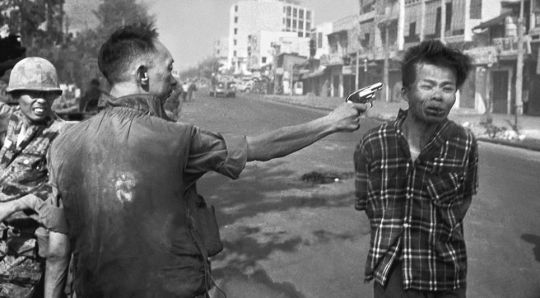
This famous image by Eddie Adams taken (1st February 1968) during the Vietnam War. The image shows the execution of a Viet Cong prisoner seconds before the gun is fired thus killing the man.
Now of course without any historical research the image still affects the viewer purely just by how horrific the situation within the photo actually is, since you are clearly able to see what is going to happen. However by revealing the information of the historical events behind the photo, it can now effect people in different ways. Depending on where you may live in the world and what their own situation and opinions are about the war itself.
1 note
·
View note
Text
Advanced Research Methods: Week 3. Advanced Research Methods: Gallery Visit - Olafur Eliasson. Journal Task 3
TASK: Write a reflection on what you saw today. Which methodology/ies could you use to analyse images from the exhibition?
Eliasson’s interest in nature, geometry and how humans perceive, feel and interact with the world around us is explored throughout the exhibition. What strikes me most about this exhibition is how has taken over the gallery; not in every room but in every aspect: indoors, outdoors, the restaurant, live link ups to his studio in Berlin, to the recycling of T-shirts in the gift shop to get a discount, nothing has been missed. It is completely interactive almost to the point of assaulting your senses.
The artwork covers the period from the 1990s to the present day which means you could analyse this work from a historical perspective.
The broad variety of the work covers several genres that could be used to analyse this exhibition: Art Theory: conceptual, abstraction, aesthetics, and environmental theory. The work covers a period of 30 years so you could also analyse this in a historical context. To give justice to this exhibition several of these methodologies would have to be used to analyse it fully. I would use those previously mentioned; historical, conceptual, abstraction and environmental.
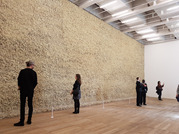
The moss wall, 1994, was revolutionary in its day but it feels out dated to me now. It would be interesting to analyse this further in the historical context to better understand the impact at the time and how that has influenced other works.
I am a lover of symmetry and geometry so the kaleidoscopes and the artwork in the model rooms were interesting but my favourite pieces were; Beauty, 1993, Your Blind Passage, 2010 and a more recent work, Big Bang Fountain, 2014.
Video: https://drive.google.com/file/d/1uvIRMIvCTE-XS6_e9b11FY66DQs_O6r5/view?usp=sharing
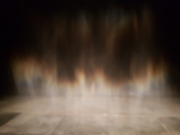
Beauty, 1993
I could have sat at the back of the room and watched this rainbow of colours pouring down all day, it made me feel completely relaxed and peaceful. Eliasson’s ‘interests in illumination, nature and perception’ was the inspiration for this piece. I would analyse it using a conceptual methodology to gain a better understanding of this piece. It might lead me onto other methodologies to investigate.
VIDEO: https://drive.google.com/file/d/1FRdn9A-FFyc9BqR3rHWf6oBo4sBTV6Xa/view?usp=sharing
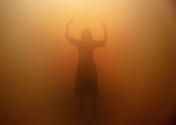
Your Blind Passage, 2010. (image from Guardian Review)
This had the most profound impact on the senses, having limited sight, the changing colours and the weird, not very pleasant taste it left behind. When one sense is blocked your other senses kick in to bridge that gap, to keep you safe, it’s a primal instinct. I suspect it is the piece that affects the audience the most and in very different ways; some love it, like me, others would hate it. Again this is very conceptual and abstract.
VIDEO: https://drive.google.com/file/d/17YcgqdNu66jvmFtCuhqLs76-H6VIfMLe/view?usp=sharing

Big Bang Fountain, 2014
It’s difficult to decide whether I prefer this artwork to Beauty. Beauty affected how I felt i.e. peaceful etc. but this intrigued me in how it affected my sight. Once my eyes adjusted to the darkness I was able to make out the different shapes and droplets of the water. It also left a residual image on my retina so that even after the water have disappeared I could still see its ghostly shadow floating in the air until it was replaced with the next ‘real’ burst of water. I would certainly look at this from a conceptual and art theory perspective.
Overall, I thoroughly enjoyed the exhibition and there is plenty of food for thought in terms of the media to use to interpret different subjects and how this could be analysed in so many different ways. However, when it came to the last room with an A-Z of different ideas and influences I had had enough to really spend any time in there to appreciate it. There was too much for a 1 hour visit. It is an exhibition that I feel needs several visits to fully appreciate it, having said that the cost is prohibitive to make that a reality.
#advancedresearchmethod#advancedmethods#journaltask3#galleryvisit#olafureliasson#6IMAG001W#MajorProject1#research#baphotography#2020
1 note
·
View note
Text
Advanced Research Method 3
9/10/2019
Week 3: Gallery Visit 1 - Olafur Eliasson at the Tate Modern
Blog task: Write a reflection on what you saw today. Which methodology/ies could you use to analyse images from the exhibition?
Today we saw Olafur Eliasson, IN REAL LIFE. This exhibition features a series of installation, photography, and sculptures mostly interactive. The way in which Eliasson decides to make the viewer engage is by introducing natural phenomena such as rain, fog or rainbow to make us aware of our senses, of other people around us, the environment and, most importantly, the planet we live in. At first, I thought there were too many people in the gallery for me to be able to experience it, but I then realised that the whole idea is the engagement that society has with the environment and it was quite interesting to see how different people were reacting to each of the installations and mediums used by the artist.

credit (Picture taken by me inside “Din blinde passager”)
The Methodology used to analyse the exhibition In Real Life is mostly aesthetic if we look at “Din blinde passager (your blind passenger)”, A 45m tunnel of fog where visitors are stepping forward with uncertainty and surprise - or the room called “Beauty, 1993″, a humid room of quiet rain&mist that creates arainbow in which the artist represent the sublime effect of nature.

credit (Beauty, 1993 Photo: Anders Sune Berg)
Both are absolutely aesthetically beautiful as well as clever and, in my opinion, it is definitely different from painting as it gave me access to all 5 senses.
Moreover, a piece such as “Your uncertain shadow (color), 2010″ gave me a doubt.

credit (Tate Modern, London Photo: Anders Sune Berg)
Is there an ethical question there? I just found it aesthetically pleasing and it could easily be that the whole idea of the artist was simply for the visitors to have fun?
With no doubt, Olafur Eliasson’s reason for emphasising the immense power of nature could almost entirely be analyses from an ethical point of view. Looking at one of his most famous piece “Ice Watch” NOBODY could fail to be aware of what is the message is.
The artist is raising a question: these beautiful installations with glaciers and rains and rainbow that you are photographing and interactively enjoying is our planet and it is melting. But does the end justify the means? The artist extracted and carried with vehicles 30 blocks of glacial ice from the waters surrounding Greenland, placing them in London and leaving them to melt. Although his intentions are certainly honest and good, his ethic for some people could be questionable.
What I found extremely interesting was at the end of the exhibition. There was a wall full of newspaper articles, interesting facts, and quotes from the artist and other sources. Although this collage looked a bit confusing at first I started taking pictures of everything so I could read them more carefully at home. Most of the articles are extremely useful for my essay for the VISION&TECHNOLOGY module as they all talk about vision and perception and the way people experience art.
If I could change something from my experience I would go back to the exhibition by my self and spend more time reading the articles as the problem I have encountered while I was there is the fact that there were too many people around ( especially students) and it was a bit distracting.

( Phone picture of an interesting quote - will use in my essay)

( Phone picture of an interesting quote - will use in my essay)

( Phone picture of an interesting quote - will use in my essay)

( Phone picture of an interesting quote - will use in my essay)

( Phone picture of an interesting quote - will use in my essay)

( OVERALL Phone picture of interesting quotes - will use in my essay)
I have decided to go back and I have bought a ticket to go again on the 20th of December !!!! In addition, I have watched Olafur Eliasson's documentary on Netflix where the artist himself explains the reason behind his work, the technicality, the ethics, and his personal life. This was extremely helpful to understand the artist point of view as well as the reason behind his work :
youtube
(Trailer of ABSTRACT: THE ART OF DESIGN Season 2 Trailer (2019) Netflix - taken from Youtube)
1 note
·
View note
Text
Advanced research methods. Lecture 1
The introduction to this module was extremely helpful in understanding the key concepts of the module, the tasks this module involves and the potential routes I may take when writing my essay. What I found most interesting is the detail you can get into when analysing with multiple methodologies. For example you may start out with a broad scope such as political theory, and then delve in deeper using a more precise theory. Alongside theoretical methodology is historical analysis, as explained to us can be used as a separate method or in unison with theoretical methods.
When thinking about an essay for this module I would like to use my prior knowledge in Historical theories and social theories to analyse a piece of work. One idea is to analyse historical issues or social issues using methodologies that stem from history theory. A photographer that I would like to do some research into is Don Mcullen and his work in Vietnam. As a piece of history it is very interesting how the wars coverage changed the worlds view on the fighting. However further research is needed on this topic.
I aim to use many forms of media to research this topic as the key will be to analyse don Mcullen’s work with a historical context. To do this I will have to understand the time period his work in Vietnam was made, by researching the time. My main aim will be to research the American culture at the time; however this war affected many other countries, so this will be taken into account. Apart from history methodology, I will look into using social, political and architectural theories as they all play a part in his work while helping me to analyse the time period.
1 note
·
View note
Text
Vilém Flusser - and his futuristic writing.

Vilém Flusser was born in Prague in 1920, he emigrated to Brazil and after 20 years later come back to Europe. He was an influential writer about many topics such a language, design, communication and photography. He died in 1991.
At the moment I’m reading his book Towards a Philosophy of Photography and I cannot stop thinking about his reflections about photography! Traditional images, technical images, windows, surfaces, apparatuses, machines, cameras, photographers, capitalism, production, human beings, world out there… Many topics is covered in his essays which I am interested to. I would like leave one recent citation from the book, which I consider as a worth text to look into photography and its philosophy in reflection to our actions on this Planet. It is a pity that Flusser died in 1991 just before the blossom of World Wide Web period and explosion of development in communication like the smartphones for instance.
“In short: Apparatuses are black boxes that simulate thinking in the sense of a combinatory game using number-like symbols; at the same time, they mechanize this thinking in such a way that, in future, human beings will become less and less competent to deal with it and have to rely more and more on apparatuses. Apparatuses are scientific black boxes that carry out this type of thinking better than human beings because they are better at playing (more quickly and with fewer errors) with number-like symbols. Even apparatuses that are not fully automated (those that need human beings as players and functionaries) play and function better than the human beings that operate them. This has to be starting point for any consideration of the act of photography” Vilém Flusser “Towards a Philosophy of Photography”
#journaltask#journal task#advanced methods#advancedmethods#furtherresearch#5imag016w#vilem flusser#apparatus#beyondtheframe#beyond the frame#philosophy#philosophy of photography#ontology
1 note
·
View note
Text
Advanced Research Methods entry 1
At first I found myself a little bit confused with the point of the lecture and the significance and purpose of methodologies themselves. That feeling quickly disappeared once we got into the practical/discussion aspect of the class though. Breaking own a multitude of images by method proved to be an effective method of demonstrating just why methods are important both in academic writing and as a part of a wholesome understanding of a piece of art. My group was "tasked" with discussing a fashion image off an unknown to me artist's photobook.(Edit: The photographer is Viviane Sassen; the image has been inserted for context and clarity.)

We started off slow but quickly picked up the pace, figuring out more and more ways to analyse the image from all sorts of different angles. We started looking at it purely photographically at first, breaking it down via artistic and photographic theory, referencing significant form, semiotics, the color palette, etc. We then dug a little deeper and started going through the different methodologies listed as examples in the powerpoint, just to see what we can get to fit and what we can't. Someone suggested exploring the image using gender theory, which I personally disagreed with as I didn't consider the sex of the subject to be of any significance to the content of the photograph we looked at.
As for why methodologies are important and I'd argue even somewhat necessary to academic writing, I find they provide a couple of very important things - they contextualise and validate our statements by directly referencing pre-established and renowned theories, effectively allowing us to make use and stand on the shoulders of very signifiant and often expansive research, without having to bother with referencing all of its intricacies (i.e. when breaking down an image using formalist analysis I don't need to go back and explain or prove why significant form is important to certain photographs). Another huge benefit at least for me is that methodologies are a great starting point for analysis - certain theories fit certain images better than others and when we constrain ourselves to using just one or two to dig into a piece of work I find it concentrates our efforts, allowing for a deeper and therefore more valuable understanding of a piece of work. Another benefit is providing a different and novel point of view, for instance, let’s take this image by Rachel Whiteread:
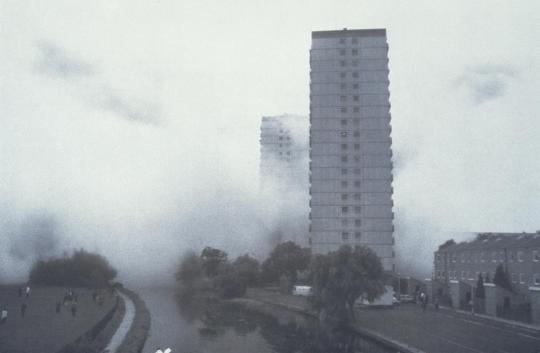
It could very well be an architecture shot or a street photograph, in which case we could employ methods better suited to its analysis as such. While that would undoubtably result in some deeper understanding of the image, it would also mean we completely miss the point of the project as a piece of documentary work, representing certain sociopolitical movements of the time as well as alluding to the artist’s own background and environment. The reason why I chose to reference this project in particular is actually a friend of mine that’s not particularly invested in art that I went to the Tate Modern with some time ago - she looked at these images and seemed really unimpressed, until reading the supporting statement on the wall - to me that’s a really practical demonstration of why methods are important - while they don’t offer a complete or rounded understanding of a piece of art, they do work well to point us in the right direction and make sure we as consumers are speaking the same language as the artist.
1 note
·
View note
Link
The concept of ‘the sublime’ historically dates back to Burke’s 1757 Philosophical Enquiry, if not even earlier in time, and to Kant’s discussion on the term, illustrated in the first part of his Critique of Judgment, 1790.
Nonetheless, arguments on such ideology are still prevalent in the modern-day. American artist Barnet Newman, in 1948, wrote a passage titled ‘The Sublime is Now’. The link above connects to Julian Bell’s online article, where the painter approaches the contemporary revisitation of ‘the sublime’ from a critical perspective. Bell adopts the artist’s viewpoint, rather than choosing a philosophical outlook.
3 notes
·
View notes
Text
week 7 - Exhibition Review
youtube

RED STAR OVER RUSSIA
It is 100 years since the October Revolution overthrew the Russian Empire when the country radically changed to a new way of life. From 1917 the Russian empire fell and the start the communist country replaced it with a new government in power. The main activist and leader of the Bolsheviks was Vladimir Lenin. He started the civil war, killed the royal family and made a big Union of the Soviet Socialist Republics which existed until 1991.
This exhibition was made from a collection of the graphic designer David King. He brought together material, photographs and posters from the Soviet times and shows the history, politics and life for a generation of people.
All these posters still today are very popular in Russia and the ex-Republics. All these objects in the exhibition attest to the role that images played in shaping the history of the period. These posters capture different moments of the life of normal people and the Leader’s words to make propaganda that people should work; that people should take a part in the elections; that Fascism was the most evil enemy of Women.
It was like graffiti on a wall and like an art form. People were admired in posters, photos and the painting of that time. It was providing information for people - so they can understand from those materials the relationship between politics and art at that time.
I took some pictures of rare posters and photos, some of them are originals. There were pieces such as paintings of Aleksandr Deineka - he depicted a parade in Red Square which includes the unrealized Palace of the Soviets in the background. Vera Mukhina, who was very well-known sculpture. made “Workers and Collective Farm Women” this sculpture celebrated the solidarity of the urban and the rural classes.
It was an exhibition in Paris in 1937 showing the sombre and often brutal reality of life in the Soviet Union. There were photos of the peak of Stalins Great Terror, during which over 1.6 million people were arrested.
That exhibition is showing us the depiction of history in many art forms. I decided that it is going to be a good an example for an exhibition review because it was a polyhedral time for art and politics. Also, i am very interested in that topic - the Soviet Union people and I this is not the first time I have used this topic for my work.







#5IMAG016W#art exhibition#review#russian revolution#red star#war#posters#photography#propaganda#deineko#vera mukhina#advancedmethods#ejournaltask
2 notes
·
View notes
Link
Secrets of Power Racquetball - Tips for Advanced Players is now available to watch video on demand.
Seven-time United States National Racquetball Champion Marty Hogan details what it takes to play the game at the highest level. He draws upon his experience and expertise to provide an incredible collection of easy-to-use, yet powerfully effective tips. Among the topics covered are: rules and regulations, conditioning, center court control, forehand, backhand, the serve, return of serve, offensive shots, back wall play, tournament play and practice tips. This program will teach you how to perform at your full potential and excel in competition.
0 notes
Photo








Yesterday I visited the Alison Jacques Gallery to see the new solo exhibition of the work of Juergen Teller. The exhibition includes images from three bodies of work: Go-Sees; Enjoy Your Life!, Junior, and a ‘visual essay’ depicting a modern fairy tale about a boy who became a king.
When looking at the images in this exhibition, I felt that it could in fact link quite well to the advanced research module and identity in particular. Many of the images, although posed, looked quite raw in terms of the clothing and the environments in which they were taken, which I think are two things that can say quite a lot about the identity of an individual. With the images of the primary school children for example, it could be said that the images are documenting the development of their identities as they grow and begin to be shaped by influences in society, those around them and also their own desires.
Below are extracts taken from the exhibition’s press release:
The Go-Sees is a seminal work from Teller’s early career. Produced over the course of one year from May 1998, and shot from the threshold to Teller’s West London studio, the title of this series documents an industry term for a photographer’s first meeting with a new model. Unlike a casting, the ‘Go-See’ is a model’s testing ground; an open-ended encounter between the photographer and model, without the prospect of a definite commission. Like casting appointments, these events determine the potential career success for the model. Teller’s series obliquely interrogates the fashion industry with which he is involved.
‘The models in Go-Sees become much more than bearers of externally directed aesthetic values. While the photographic gaze is shaped by and reciprocally shapes the convention of the go-see, Teller suggests that even within these parameters it is possible to find new ways of seeing.’ Shannan Peckham, Juergen Teller Go-Sees, published by Scalo, 1999.
Framed by the doorway of Teller’s studio, the Go-Sees are depicted in many guises: shy, confident, hopeful, disengaged, energetic, relaxed, and in casual clothing. Transgressing fine art and fashion photography, the portraits, as with all of Teller’s other work, are never retouched. Teller’s snapshot style and spontaneous and unusual angles defer from the polished visual protocols so closely associated with the luxury world.
Shown concurrently in the smaller exhibition room, Enjoy Your Life! Junior is the result of a school-led outing by 6 and 7-year-old students of Bubenreuth Primary to see Teller’s exhibition Juergen Teller at Kunstpalais in Erlangen (2017). An unusual exhibition to take primary school students to, the children were surprised and inspired by the honesty in Teller’s work. Reversing the situation of Go-Sees, Teller responded to the students’ enthusiasm with a spontaneous visit to the school during which he encouraged them to take photographs of each other and the artist himself. Subverting the conventional relationship of the artist and model, the children playfully re-enact some of Teller’s most iconic images.
Teller’s display of the Bubenreuth Primary kids’ photographs invites viewers to play a role in recollection, as one body of work develops from another and remind us of Teller’s humour, self-mockery and emotional honesty.
This exhibition explores the development of Teller’s work over the last two decades and its ability to change the perception of stereotypical ideals of beauty and aesthetics within present-time. The exhibition culminates in the upstairs gallery where a new body of work, shown for the first time, creates a visual narrative of a modern fairy tale; a portrait of a man born in London, a boy who became a king.
https://www.alisonjacquesgallery.com/exhibitions/158/overview/
2 notes
·
View notes
Video
tumblr
Have A Joyous, Peaceful & Love-Filled Christmas!” Happy Marry Christmas in Advance!!
Christmas celebrates the birth of Jesus Christ, who Christians believe is the son of God. His birth date is unknown because there is little information about his early life.
The word “Christmas” comes from the old English “Cristes maesse”, or the mass of Christ. It is likely that the Christmas date of December 25 was chosen to offset the Pagan celebrations of Saturnalia and Natalis Invicti. It it also possible that the celebration of the birth of the “true light of the world” was set at the time of the December Solstice because this is when the days in the northern hemisphere begin to grow longer. Christmas holiday customs derive from various cultures, including Teutonic, Celtic, Roman, West Asian and Christian.
Fpsjob.com Team Wishing You Happy Christmas In Advance!
0 notes
Text
Art History and Theory as Method

(week 4)
For todays lecture I had chosen to bring in my copy of the the Shape of Light catalogue, which I bought during our visit to the exhibition back in the first year of the course. - A catalogue is a list of the works included in an exhibition.
Discuss how you might use areas of the history and/or theory of art in analysing some appropriate images.
It is clear that art history and photography have a very close connection between one another.This is due to the fact that once photography really came into existence the two mediums would take inspiration from each other.
A great example of this would be looking at the artist, Juan Sanchez Cotan (born 1561) who had painted the well known piece, “Quince, Cabbage, Melon and Cucumber”. The painting shows these products within what looks to be a small cove in a wall acting as a shelf. Both the quince and the cabbage are being suspended in the air by two pieces of string, leaving the melon and the cucumber laying on the shelf. I think this is a perfect example for what I stated in my opening since many years later this image was actually recreated by an American photographer named Paulette Tavormina in 2010.
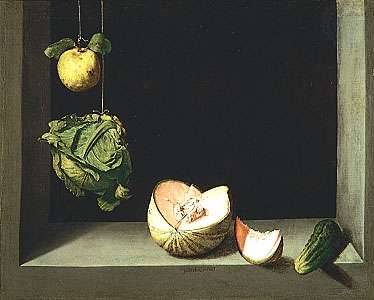
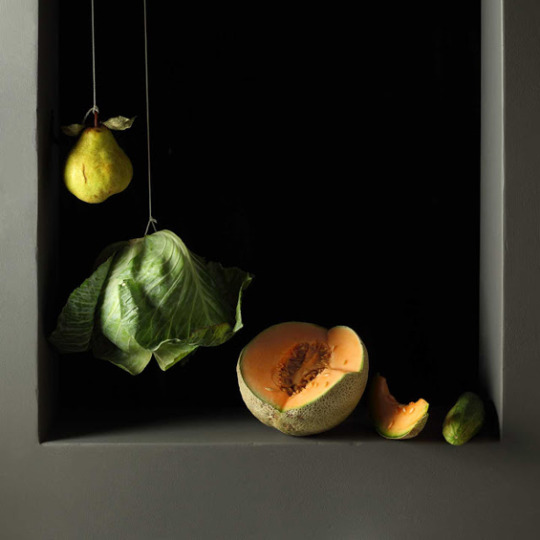
Even though that in my opinion Tavormina’s version is a lot less dramatic since I think it holds a lot less detail compared to the actual painting, but it still holds a certain charm to its slightly more minimalist style as it almost allows you to split the images into different sections, causing you to shift your focus from one object to another rather than giving you that wider scale of a painting which can sometimes force you to be stuck in the mind frame of it being one singular piece that is to be examined as a whole.
1 note
·
View note
Text
Group presentation seminar
For the Advanced Research Methods seminar presentation group work, we got given the task to elaborate on the method of Art Theory. Upon meeting with our Tutor, we chose to focus our work around Conceptual Art. We split the theme into different sections, so each one of us would mention different aspects of this movement, as well as the different artists that took part or got influenced by it.
My part of the presentation was about the historical and political dimension of the movement, so i ended up picking a Chilean Art collective that went by the name of COLECTIVO ACCIONES DE ARTE (C.A.D.A.).
This collective was mainly active from 1979 to 1985, after the dictatorship that oppressed most Chilean Art from 1973 went down. Their work was mainly revolved around the dictatorship years and the effects of it on the newly democratic Chile. Their pieces were usually public displays of art or performances which the general public could participate in, and they were highly political and disruptive.
To showcase their work, I started by mentioning the history behind the collective, and the social and political situation at the time, followed by three examples of their most famous pieces : “No Mas” (), “Para no morir de hambre en el arte (Not to Die of Hunger in Art)”,and “¡Ay Sudamérica!”.
While researching for the presentation I found a lot of new information about not only Chile but other South American Countries and how conceptual art took form there. There were major similarities to the art that was coming from the US but adapted to a different way of living. This example was most clear in the second work that I analyzed, where the bottle of milk was a symbol of human rights and social necessities. This can be compared to works from American artists that used products and consumerism to make similar statements.
Being the collective active a little after conceptual art sprawled out as a movement, due to the oppression of art during the dictatorship years, is also interesting as we can see their works as responses to American Artists that pioneered conceptual art.
Overall, I think the seminar group work was very productive, as it challenged us to put together different types of artists (in our case every artist was from different nationalities) with different perspectives of what conceptual art meant as a medium for them. Furthermore, how history, social and the political situation of the artists country influenced their work.
I will definitely look into incorporating some of what I learned in my future work and upcoming essay, in regard to history and art.
0 notes
